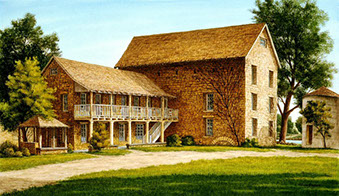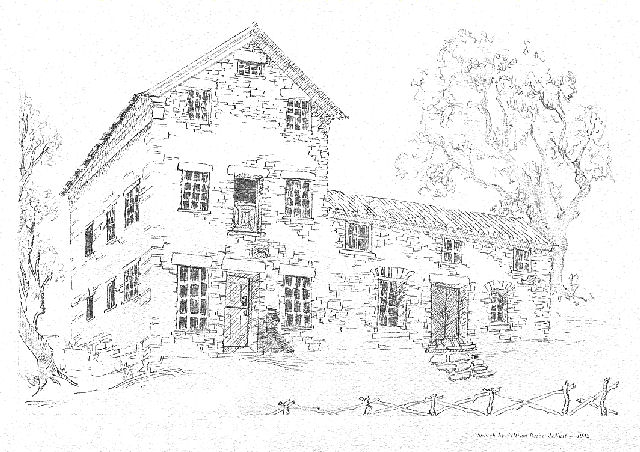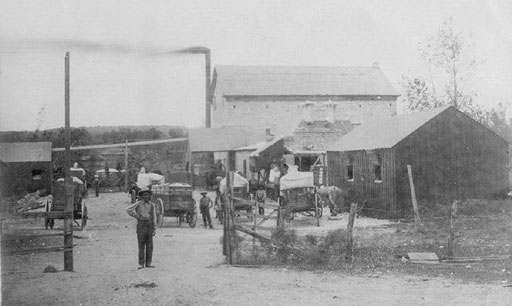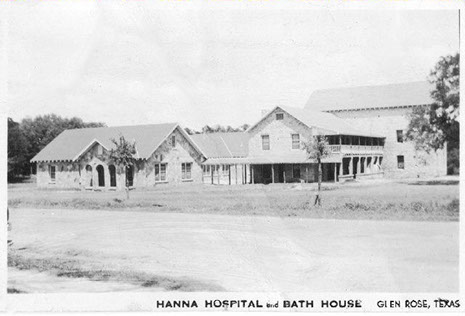Somervell History Foundation
Formed in 2000, the Somervell History Foundation is a 501(c)3 non-profit membership organization. Even in those early days of the Foundation, the group was filled with the spirit and progressive ideals that have grown into the fulfillment of a dream.
In September 2007, the founders watched their first plans bring a Robert Summers' bronze, The Barnards of the Brazos, "First Family of Glen Rose", to the Historic Courthouse Square. Their foresight set the stage for their next dream. Mr. Richard H. Moore, Jr. owner of Barnard's Mill and Art Museum, recognized the spirit and determination of the Foundation and deeded, as a gift, his personal home, Barnard’s Mill and Art Museum, to the Somervell History Foundation. Now the Foundation is building a new dream, the restoration of the museums.

The Foundation has received a matching funds grant from the Texas Historical Commission to be used for setting the Foundation for their next project, to restore and preserve the Mill the art galleries.
To accomplish this mission the following goals were adopted:
- To provide educational, historical, and cultural activities for area schools.
- To provide cultural programs and tours to educate visitors on the history of Banard's Mill and the of the surrounding areas.
- To educate current residents and new settlers to the cultural and historical values of the area.
- To restore and preserve Barnard's Mill and Art Museum.
Somervell History Foundation's base and strength is its members and its primary focus in this community is its unique responsibility in preserving Barnard's Mill and Art Museum. The Board of Directors works diligently to raise funds and plan exciting events that stimulate interest in the Mill.
Barnard's Mill & Art Museum
The history of Somervell County begins with a small trading post on the banks of the Paluxy River now known today as the City of Glen Rose. The mill started as a water-powered gristmill in 1860 then to a steam-powered burr mill. It was sold for $10 and turned into a cotton gin in 1895, a health spa with mineral waters in 1943, a hospital and clinic in 1949, and today a Historical Mill and Art Museum.
The Beginning
 Charles E. Barnard and Herman Quimby enjoyed lucrative trading with the Indians during the years between 1847 and 1855. By 1860, Barnard had contracted with Milam County for land on the river and began construction of Barnard’s Mill. The foundation is 25 feet deep and rests on the bedrock of the Paluxy River. Oxen from East Texas hauled hand hewn timbers and its great oak beams support the various floors. The three-storied structure is made of native limestone and its water-powered turbine was designed to be the most advanced technologically in the area. The gristmill was capable of turning out the finest flour and corn meal and demand was from as far away as Waco.
Charles E. Barnard and Herman Quimby enjoyed lucrative trading with the Indians during the years between 1847 and 1855. By 1860, Barnard had contracted with Milam County for land on the river and began construction of Barnard’s Mill. The foundation is 25 feet deep and rests on the bedrock of the Paluxy River. Oxen from East Texas hauled hand hewn timbers and its great oak beams support the various floors. The three-storied structure is made of native limestone and its water-powered turbine was designed to be the most advanced technologically in the area. The gristmill was capable of turning out the finest flour and corn meal and demand was from as far away as Waco.
On the 24th of April, 1874 Charles E. Barnard sold the mill to Major T. C. Jordan of Dallas who took over operation of the mill. Times were changing and the community was growing. The citizens signed a charter requesting the State Legislature to establish a new county and on March 15, 1875, Somervell County was created.
Jordan soon made an agreement with the leading citizens and encouraged the building of the first courthouse. Jordan operated the gristmill a few years, but with changing times he began to consider adding a burr mill. The operation was by steam and daily business continued until financial problems developed.
 By 1892 Jordan and his wife were living in the Territory of Arizona. On January 3, 1893, a contract was made and Jordan who sold the mill to A. J Price of Somervell County for the sum of $10.00. A. J. Price began his operation of the mill and with cotton being a major crop in the area, the cotton gin was installed in 1895 and a steam powered compress was added.
By 1892 Jordan and his wife were living in the Territory of Arizona. On January 3, 1893, a contract was made and Jordan who sold the mill to A. J Price of Somervell County for the sum of $10.00. A. J. Price began his operation of the mill and with cotton being a major crop in the area, the cotton gin was installed in 1895 and a steam powered compress was added.
The new age had arrived as wagons filled with cotton were hauled through the roads to the mill.
Production ran day and night during this time. The low hum of the machinery rocked its neighbors to sleep and by day the sound of turning of the wagon wheels filled the air. The roads from the mill past the courthouse and to the bend of Barnard Street were lined with wagons filled with the massive bales of cotton on their way to the nearest railroad. A cottonseed silo was built for storage and every vacant lot in town was filled with cotton bales waiting their turn for delivery.
 On April 2, 1943, the estate of Mr. Price sold the mill to Dr. J. J. Hanna. Dr. Hanna had visions of a place of healing waters and set up a clinic for arthritic patients using the first floor as a water therapy room. He considered the mineral waters from the flowing springs in the area to be of therapeutic value to those who suffered from various health problems. World War II intervened and the venture was short-lived. Dr. Hanna added a wing to the original building and opened a less specialized hospital.
On April 2, 1943, the estate of Mr. Price sold the mill to Dr. J. J. Hanna. Dr. Hanna had visions of a place of healing waters and set up a clinic for arthritic patients using the first floor as a water therapy room. He considered the mineral waters from the flowing springs in the area to be of therapeutic value to those who suffered from various health problems. World War II intervened and the venture was short-lived. Dr. Hanna added a wing to the original building and opened a less specialized hospital.
His daughter, Dr. Mildred Hanna, became the resident doctor. The hospital filled a great need to the community and during the next few years several doctors came through the doors. In December of 1949, Dr. Roger Marks arrived and set up practice within the hospital. On December 27 1955, the Hanna Family sold the hospital to Dr. Roger Marks and Dr. Robert English. The building became the Marks-English Hospital and Clinic.
Dr. Roger E. Marks and Dr. Robert D. English put their lives into the Marks-English Hospital and Clinic. Barnard’s Mill served the hospital well over the years. Some areas were used as the kitchen, the dining room, and rooms for therapy and staff. The Marks-English Hospital and Clinic, which was located in the Barnard’s Mill complex, nurtured the citizens of Somervell County and surrounding areas.
Dr. Roger Marks continued his practice at this location until the present day hospital was built on Highway 67.
 Barnard’s Mill and the old Marks-English hospital sat vacant most of the next few years. The Marks-English families sold Barnard’s Mill to Richard H. Moore, Jr. Richard Moore bought the Marks-English Hospital and Clinic on August 2, 1979. The facility sat empty for a number of years and over the next seven years he restored and furnished it with antiques from the Federal period to the Eastlake period (1775-1875). He established Barnard’s Mill Art Museum in the old hospital addition and filled it with the art collection from the Fielder Foundation and art works of his private collection.
Barnard’s Mill and the old Marks-English hospital sat vacant most of the next few years. The Marks-English families sold Barnard’s Mill to Richard H. Moore, Jr. Richard Moore bought the Marks-English Hospital and Clinic on August 2, 1979. The facility sat empty for a number of years and over the next seven years he restored and furnished it with antiques from the Federal period to the Eastlake period (1775-1875). He established Barnard’s Mill Art Museum in the old hospital addition and filled it with the art collection from the Fielder Foundation and art works of his private collection.
In 2005, Mr. Moore began to explore the idea of making a gift of Barnard’s Mill to an organization he had observed for several years. He wanted to be sure his prize would be protected and enhanced upon and that the organization he chose would be able to have a dream and follow it through. In 2005, Mr. Moore announced that he had chosen the Somervell History Foundation and presented the Foundation with a deed to Barnard’s Mill. In 2008, he deeded the Art Museum building to the Foundation.
